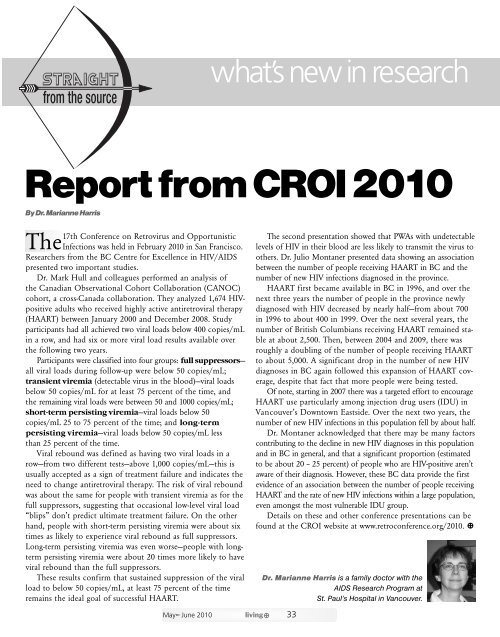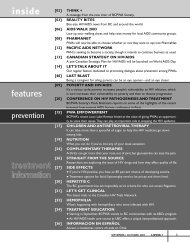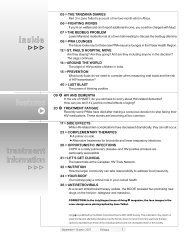liv poz mag.qxd - Positive Living BC
liv poz mag.qxd - Positive Living BC
liv poz mag.qxd - Positive Living BC
Create successful ePaper yourself
Turn your PDF publications into a flip-book with our unique Google optimized e-Paper software.
what’s new in research<br />
Report from CROI 2010<br />
By Dr. Marianne Harris<br />
The<br />
17th Conference on Retrovirus and Opportunistic<br />
Infections was held in February 2010 in San Francisco.<br />
Researchers from the <strong>BC</strong> Centre for Excellence in HIV/AIDS<br />
presented two important studies.<br />
Dr. Mark Hull and colleagues performed an analysis of<br />
the Canadian Observational Cohort Collaboration (CANOC)<br />
cohort, a cross-Canada collaboration. They analyzed 1,674 HIVpositive<br />
adults who received highly active antiretroviral therapy<br />
(HAART) between January 2000 and December 2008. Study<br />
participants had all achieved two viral loads below 400 copies/mL<br />
in a row, and had six or more viral load results available over<br />
the following two years.<br />
Participants were classified into four groups: full suppressors—<br />
all viral loads during follow-up were below 50 copies/mL;<br />
transient viremia (detectable virus in the blood)—viral loads<br />
below 50 copies/mL for at least 75 percent of the time, and<br />
the remaining viral loads were between 50 and 1000 copies/mL;<br />
short-term persisting viremia—viral loads below 50<br />
copies/mL 25 to 75 percent of the time; and long-term<br />
persisting viremia—viral loads below 50 copies/mL less<br />
than 25 percent of the time.<br />
Viral rebound was defined as having two viral loads in a<br />
row—from two different tests—above 1,000 copies/mL—this is<br />
usually accepted as a sign of treatment failure and indicates the<br />
need to change antiretroviral therapy. The risk of viral rebound<br />
was about the same for people with transient viremia as for the<br />
full suppressors, suggesting that occasional low-level viral load<br />
“blips” don’t predict ultimate treatment failure. On the other<br />
hand, people with short-term persisting viremia were about six<br />
times as likely to experience viral rebound as full suppressors.<br />
Long-term persisting viremia was even worse—people with longterm<br />
persisting viremia were about 20 times more likely to have<br />
viral rebound than the full suppressors.<br />
These results confirm that sustained suppression of the viral<br />
load to below 50 copies/mL, at least 75 percent of the time<br />
remains the ideal goal of successful HAART.<br />
The second presentation showed that PWAs with undetectable<br />
levels of HIV in their blood are less likely to transmit the virus to<br />
others. Dr. Julio Montaner presented data showing an association<br />
between the number of people receiving HAART in <strong>BC</strong> and the<br />
number of new HIV infections diagnosed in the province.<br />
HAART first became available in <strong>BC</strong> in 1996, and over the<br />
next three years the number of people in the province newly<br />
diagnosed with HIV decreased by nearly half—from about 700<br />
in 1996 to about 400 in 1999. Over the next several years, the<br />
number of British Columbians receiving HAART remained stable<br />
at about 2,500. Then, between 2004 and 2009, there was<br />
roughly a doubling of the number of people receiving HAART<br />
to about 5,000. A significant drop in the number of new HIV<br />
diagnoses in <strong>BC</strong> again followed this expansion of HAART coverage,<br />
despite that fact that more people were being tested.<br />
Of note, starting in 2007 there was a targeted effort to encourage<br />
HAART use particularly among injection drug users (IDU) in<br />
Vancouver’s Downtown Eastside. Over the next two years, the<br />
number of new HIV infections in this population fell by about half.<br />
Dr. Montaner acknowledged that there may be many factors<br />
contributing to the decline in new HIV diagnoses in this population<br />
and in <strong>BC</strong> in general, and that a significant proportion (estimated<br />
to be about 20 – 25 percent) of people who are HIV-positive aren’t<br />
aware of their diagnosis. However, these <strong>BC</strong> data provide the first<br />
evidence of an association between the number of people receiving<br />
HAART and the rate of new HIV infections within a large population,<br />
even amongst the most vulnerable IDU group.<br />
Details on these and other conference presentations can be<br />
found at the CROI website at www.retroconference.org/2010. 5<br />
Dr. Marianne Harris is a family doctor with the<br />
AIDS Research Program at<br />
St. Paul’s Hospital in Vancouver.<br />
MayqJune 2010 <strong>liv</strong>ing5 33











